Hey there! This post contains affiliate links. Using my links means I earn a commission, which helps me create more rad content. More on affiliates here.
As you may know, I’m working on my first luxury fashion collection. And, well, if you didn’t know.. you NOW know!
Over the last year, I’ve been sharing behind-the-scenes pictures of my sewing on social media. From putting in zippers to buttonholes, to hand sewing on appliqué using couture sewing techniques, there’s been a LOT going on.
Publishing Date & Update
Note: This blog post was written on November 18, 2018. I have since updated it to capitalize the “B” in “Black,” and add a link to Black sewing bloggers to follow.
All the photos and screenshots are from 2018. How have these brands shaped up? Which brands are still failing?
As I’ve shared images from my sewing studio, i’ve made some sewing besties online. This last weekend, one of those friends popped into my Instagram DMs. She is an avid sewist, with quite a large following, and she shared this:
She’s a black woman from the South, who is not seeing herself in any sewing or crafting advertisements.
Zero.
Zilch.
No Black women in crafting company imagery or on the feeds of sewing machine brands.
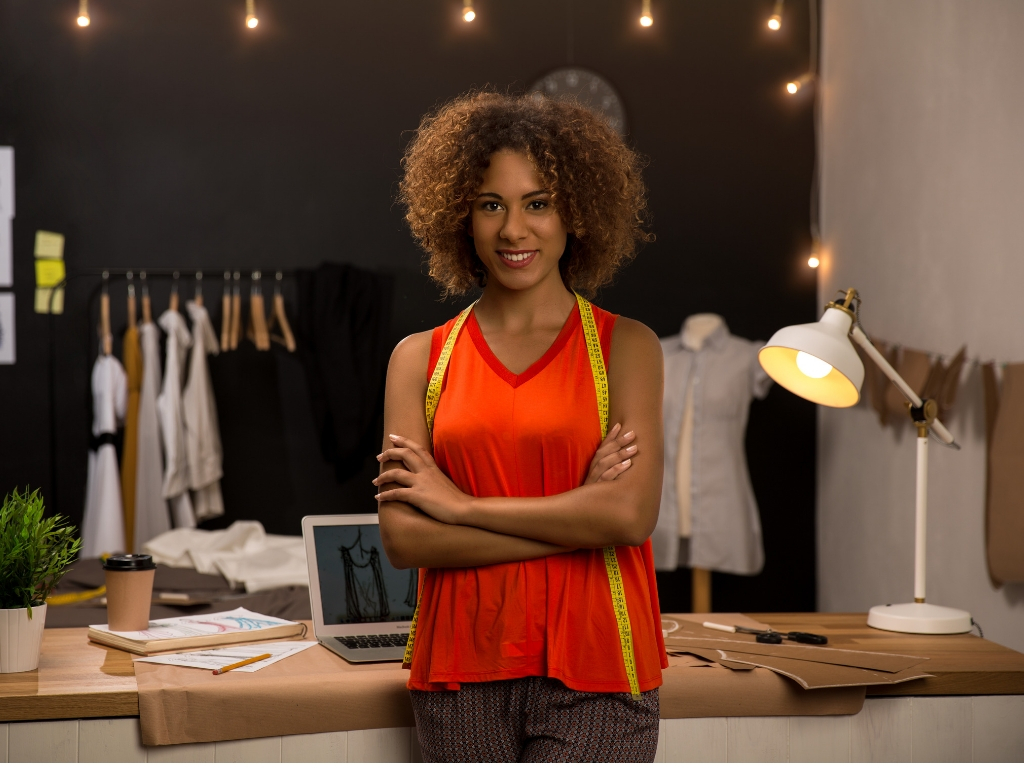
As we chatted back and forth, I realized she was totally right. She’s purchased quite a few Brother Sewing products over the years (she makes most of her own clothing, as well as clothing for her family!), and she doesn’t see herself reflected in ANY of their advertising.
Time to Call Out Brands
As a white ally, I think of it as my job to write about and bring attention to issues like this. My friend is a blogger who wants to work with sewing machine brands, and oftentimes bringing (valid and loving) critique to a brand’s attention means the brand won’t ever work with you.It’s a sort of “shoot the messenger” kind of deal.
And, real talk, there is a whoooole lot of negative stereotyping around Black women sharing critique (unfamiliar with this? Google “angry black woman stereotype”.)

So, I decided to jump on in (checking in with my friend that it was okay to do so), and share a critique of the lack of diversity in home sewing marketing. Crafting is a $36 BILLION dollar industry, and it’s shocking and upsetting that it’s so focused on white people. As millennials start taking up more market share (Forbes), diverse marketing is critical for brand survival.
Let’s Call In These Brands
As you read this blog post, you’ll notie that a lot of these brands haven’t done much. Take a few seconds to DM them on Instagram or chat them on fAcebook, and ask, “Why are there no Black people on your social media feeds?”
Companies listen to customers. But you have to speak up.
How It Started: Brother Sewing
Aaaand here is a screenshot of Brother Sewing’s Instagram. Real talk, you know what’s funny? If my friend, let’s call her Stacy (s/o to Stacy Abrams) hadn’t pointed out the issue on their Instagram, I doubt I would’ve noticed it.
Do you see it?
It’s. All. White. People.
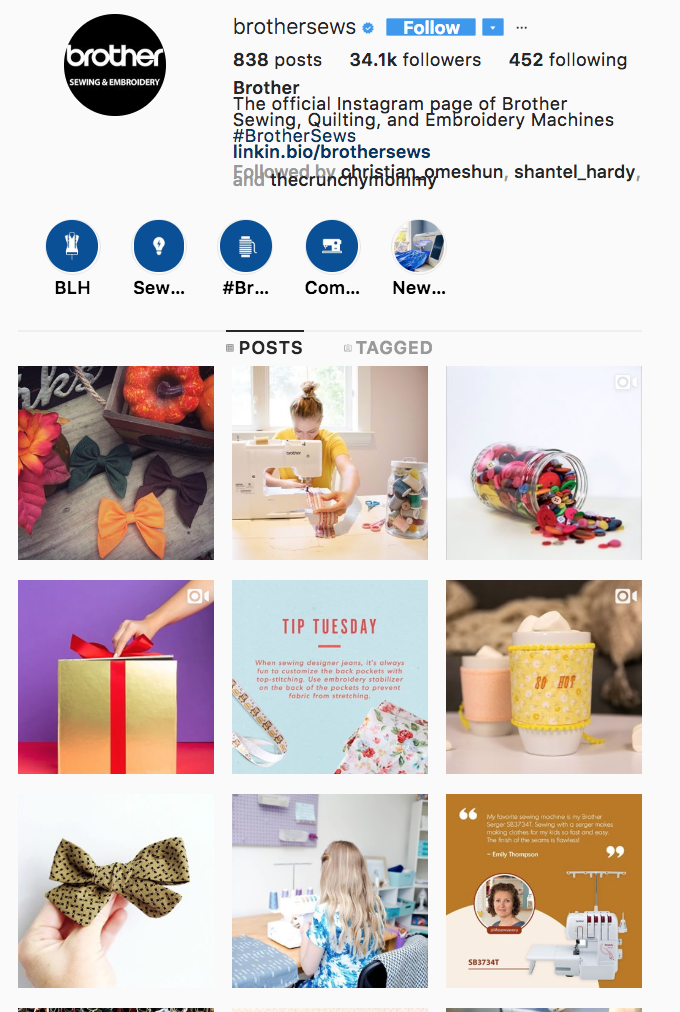
You don’t see a black person on their Instagram feed until you scroll back about six months, to June of 2018. And when you do, it’s not a black blogger or sewing enthusiast – it’s a child. It isn’t until May, after scrolling past maaaaany white/blonde people using and sharing testimonials about their products, that we get to a woman of color.
If you want to see a black person (who is tagged, and isn’t modeling in a stock photo), you’ll have to go MARCH, to see Project Runway contestant, Ken Laurence, on a sewing machine.
Well, this isn’t okay, I thought to myself. Brother Sewing needs to GET IT TOGETHER and show the diversity of their customer base. The story is the same on the Brother Sewing Facebook page. Over 300,000 followers, and no black people using their machines since March. 8 months ago.
It’s wild to me that Brother Sewing spends SO MUCH on advertising (hello, 20+ seasons of Project Runway!!), but they haven’t done an analysis of the diversity of their marketing.
People are far less likely to buy your products if they can’t see someone who looks like them using them.
A Key Assumption – What is Race?
Self-professed “Devil’s advocates” may say, “But BRI!! You can’t tell someone’s race just by LOOKING at them!!”
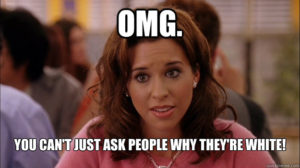
You are 100% accurate. But if there were “racially ambiguous” people we would notice, right? And, even if there are fairer skinned people of color on the Brother feed who are black – there would still be rampant colorism.
Colorism is when people of color with lighter skin are given preference over those with darker skin tones. For example, in the film industry, people of color often talk about the “paper bag test,” where African American stars are only cast if their skin is lighter than a brown paper bag. It makes the success of actresses like Viola Davis that much more impressive, as there is this extra layer of racism that darker skinned actors have to overcome.
Even if everyone on the Brother Sewing feed was a person of color (I’m betting money they’re not), then Brother Sewing would still be practicing colorism – only displaying people of color with light skin.
In Case You Didn’t Know: Black Women Sew
A majority of the indie fashion designers, sewists and craft bloggers that I know are Black women and women of color. I went through and made a list, looking at who my friends are and who I follow on social media.
Of the ~30 people I follow who are designers or sewing bloggers, 17 of them are black women, and 5 of them are women of color. That’s close to 75%.
Showing diverse people on social media isn’t just the right thing to do. It makes BUSINESS sense.
From HuffPost: “Black women are setting trends in many areas of consumerism, according to a recent report by Nielsen […]The report found black women also shop with a cause, supporting businesses that align with their values and beliefs. Sixty percent of black women are more likely to purchase brands that support a cause they care about (7 percent higher than non-Hispanic white women).”
Altogether, black people have $1.2 trillion spending power of black people overall, with a lot of that purchasing power resting in black women – who make a majority of spending decisions for their households (HuffPost).

What about Other Brands?
I’ve done quite a bit of work in the diversity in tech space, so seeing Brother Sewing’s not-so-great-advertising, made me wonder: What about other large sewing machine companies? How are they doing? Is Brother Sewing the odd one out, or are they an example of a larger problem?
So, I went to the profiles of four other major players in the home sewing industry: Pfaff, Bernina, Janome and Singer.
Pfaff Instagram & Facebook
Founded in 1862, Pfaff Sewing is headquarter’d in Germany. Gotta love that German engineering!
Of the last 15 photos on the Pfaff Instagram that feature people or hands, 1 is of a woman of color – which is 6% of their photos. I wonder, do women of color only make up 6% of their customer base?
Like Bernina, Pfaff posts the same images to their Facebook page as they do their Instagram, so the numbers were the same there.
Also, fact-to-know: I own and use a Pfaff machine everyday.
Further down, I’ve shared advice for sewing companies, on how to diversify their marketing images. If you use a Pfaff machine, please take a moment to message them and share that you want to see diversity!!
Bernina Instagram & Facebook
Founded in 1893 in Switzerland, Bernina machines are heirlooms passed down through families. My family has a Bernina that was made in the 1960’s, that still works perfectly. My fashion mentor at the Fashion Sewing School in Salt Lake City, Utah, only uses Bernina machines.
I <3 Bernina machines!!
Scrolling through the Bernina Instagram (47,600 followers), you’ll see a lot of high tech content. From regular stitches and machines to super technical touch screens, Bernina is clearly courting the millennial market.
Unfortunately, Bernina is missing a huge customer segment. On their Instagram, I had to scroll back to April of 2018 (6 months) before seeing a black person. I saw more images of cats and dogs than black people. Yikes.
There was a post featuring an Asian woman in July. However, I went through over 30 images featuring white/fair people, before getting to this post:
The story is similar on their USA Facebook page, which has 169,000+ followers. While looking for their Facebook page, I noticed they had a Facebook page for RSA – or South Africa. That page had quite a bit of diversity (thank god), with images of black people, quite a few of them entrepreneurs, posted throughout the year.
UPDATE: Bernina Sewing responded to the article, sharing that they will be increasing the diverse representation in their marketing. Thanks, Bernina!
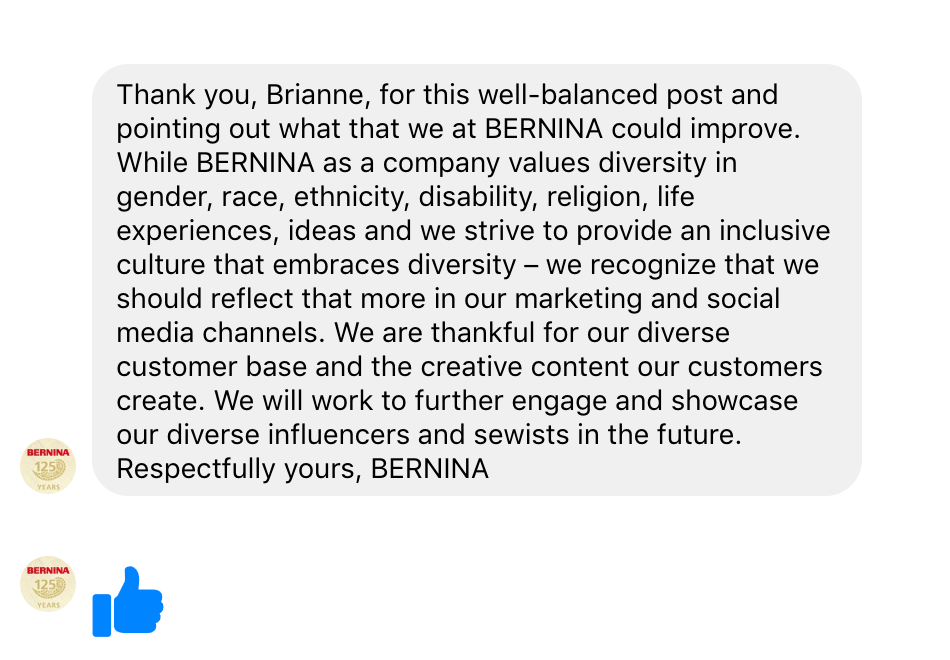
Further down, I’ve shared advice for sewing companies, on how to diversify their marketing images.
Janome Instagram & Facebook
Janome was founded in 1921, in Japan.
Their Instagram feed (12,000 followers), and I had to scroll back to March of 2016(!!) to find an image of a black woman. That’s over 2 years ago, folks!
The Janome Facebook Page has almost 80,000 followers, and also posts the same images to Facebook and Instagram.
Yikes. It doesn’t seem like a sound business strategy to limit your market to white suburban women.
Further down, I’ve shared advice for sewing companies, on how to diversify their marketing images.
Singer
Founded in 1851 in New York, Singer is really dominating the direct-to-consumer market, flooding JoAnn’s and Amazon with their ~$200 starter sewing machine.
The brand also makes higher end machines.
Looking at their Instagram, this image is very quickly visible:
This features a black woman from overseas, who is using an antique sewing machine. The One Good Tote Foundation is a worthy cause! However, there were SEVEN photos ft white folks before this one. There’s also the issue of the only Black or PoC shown being one that the brand has helped – this is white saviorism.
I wondered, How long to find an image of a black woman in the USA using a machine?
It took until I scrolled back to May:
Now, this is pretty similar to the other brands.
Aaaand, you guessed it, they post the same images to their Facebook Page (85,000 followers) as they do their Instagram page.
If you have a Singer machine, take a moment to send a message to the brand to let them know that diversity is important to you!
So, What Can We, The People, Do?
In my work as a social media marketer, I have seen companies make amazing strides for diversity – when customers and potential customers share their discomfort at the lack of marketing.
I have spent countless hours going through social media, and screenshot posts from people sharing their critique, to present to c-level executives and board members.
Public critique on social media channels get noticed. They are discussed in boardrooms, Slack channels and by the water cooler. Companies spend MILLIONS of dollars each year tracking how people feel about their brand. Sharing disappointment/displeasure on social media is one of the best ways to get a brand to change.
Here’s what YOU can do (pick one action item for at least one brand, or do each item for your favorite brand/the one you use):
1. Share this article on social media (make sure it’s public) and tag the company names of the orgs listed in this post. On Facebook, you can use the “@” symbol. If you’re more of a twitter kind of gal, here are the handles of three of these companies that are on Twiter: @BrotherSews, @Singer Co, and @Janome_America. Use #SewInColor in your post.
Hey @Janome_America @JanomeSewing are you aware that only 15% of your social media images show non-white people? I wrote an analysis on the diversity of your marketing here: https://t.co/gxgSm9btKD #SewInColor #Sewist pic.twitter.com/9NhvQ1EuH5
— Brianne – Hire Black Trans Women!! (@the_huntswoman) November 26, 2018
2. Write an email to their contact or fill out a customer support form. Example message: Hi there, I have recently read an article (LINK) about the lack of diversity in your marketing. This has been disappointing to me, as I’m such a fan of [brand name]. I don’t think that this was malicious on [brand name’s] part, but I do hope you do better in 2019. [If you use this brand, share what machine you own. If you don’t, don’t worry about it!] . Best, [Your Name]
3. Comment on their latest Instagram or Facebook post about their marketing practices. “I am disappointed to only see white people on your social media feeds. Can you please add more diverse sewers? #SewInColor.”
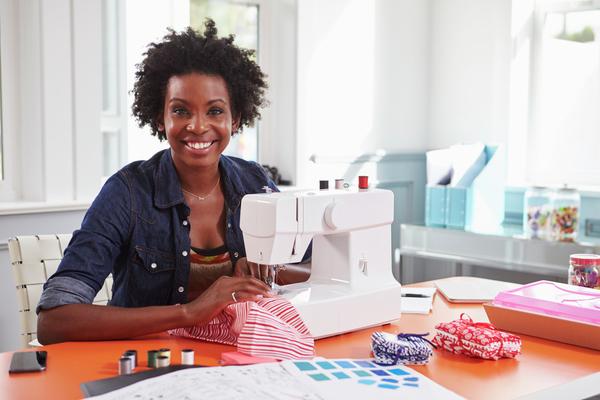
UPDATE! #4. Follow Black Sewing Bloggers! These brands need to partner with bloggers to show their true support of diverse people, and brands care about follower numbers. I’ve shared this list with bloggers to check out. Don’t follow just to follow, you only need to follow the ones who create content that matches up to your interests!
Click here!
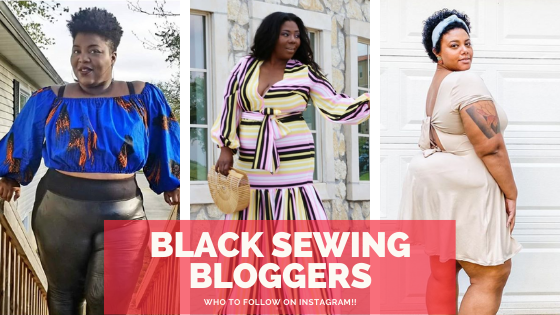
Advice for Brands
If you’ve landed down here, it may likely be because your a brand rep (or you’re interested in advice). Here are some easy ways to add more diverse people to your budget, without putting together an expensive product shoot (although, you should probably do that, too):
- Make it your goal to reflect your customer base. If you’re not sure what the demographics of your customer base are, aim for 1 diverse person (male, LGBTQIA, person of color, etc) for every white woman you post. Make sure to post a photo with person of color for every 3 images that display people.
- Regram and Repost: UGC (user generated content) is your new best friend. Check Instagram for sewists and sewing enthusiasts who have tagged you in their pictures, used your hashtags, etc. Comment as the brand, and ask for their permission to #regram their photo. VOILA! Content you didn’t have to create, and doing this will incentivize other customers to post showcasing your products, helping to raise brand visibility.
- Utilize Influencer Marketing: There are SO MANY African American and Black sewing bloggers and indie designers. These people create high quality content for their followers EVERYDAY, and they are followed by people who look like them. Diversify your customer base by partnering with influencers for product launches, reviews, etc. Sewing aficionados is truly a community – Facebook and Instagram Lives, blog posts from sewing bloggers, tutorials, etc, are a great way to engage with your customer base.
- Hire a marketing consultant: If your’e worried that your (white) managers and company leadership won’t listen to you, I’m down to present to them (consulting site here). I’m not going to show up with a protest sign (yet). If your leadership is open to a discussion on diverse marketing practices, you would be MUCH better off hiring a woman of color to come present – email me, I have recommendations.
Finally.
This article has shared a discussion about the politics and dollars behind diverse marketing. My goal is not to shame brands – because that often doesn’t lead to change. I want to see home sewing brands, like Brother, Bernina, Janome, Pfaff and Singer, reflect the diversity of their customers.
If you’d like to keep in touch, be sure to subscribe to my newsletter, so you’ll stay up-to-date on new reviews, critiques and plus size fashion content!

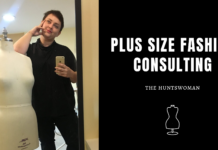
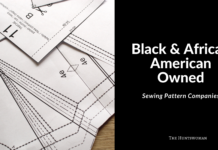









… Buttonholes. I think you mean buttonholes.
OMG THANK YOU!
You should belong to some of the Facebook groups regarding sewing that I do. There numerous posts of beautiful makes that are modeled by diverse ethic groups ( especially black ) as the Facebook group is world wide. Like you, many of the makes are modeled by young people ( both male and female) which makes me happy.
Maybe the big companies could some of these as examples?
OOO! Can you share links to a few of these groups?
You belong to groups totaling 75% who are black.. I wonder why. Yes the companies should have more diversity but they don’t want to loose sales. I do business with an Amish man who does a wonderful job. Do we need to see more Amish in ads? Do we need to see more left handed people struggling to use a machine made for righted people? Do we need to see more people of all kinds modeling who are just asking for trouble. I think you know what I am saying and thinking. No ad is prefect.
I’ve quoted your reply and responded inline.
“Yes the companies should have more diversity but they don’t want to loose sales.” If a company thinks that having black people in their advertising will lose them sales, then I don’t want to support that company. That’s racist thinking.
“Do we need to see more left handed people struggling to see a machine made for right handed people?” Well, why not? Why is showing different abilities a bad thing?
“Do we need to see more people of all kinds modeling who are just asking for trouble.” Okay, there are two ways to interpret that. The first is that black people “ask for trouble” so shouldn’t be in ads. That’s racist.
The second way to interpret that sentence is that *I’m* asking for trouble. If asking for diverse representation is asking for trouble, then you can call me Ms. Trouble! I am making noise. because the ad campaigns of these companies are racist.
“I think you know what I am saying and thinking.” Yeah, I do. You’re being racist. You are a racist. Your arguments are circuitous, and frankly speaks to white supremacist thinking.
“No ad is perfect.” You’re right! No ad is perfect – but these ads are SOOOO far from perfect that there’s easy fixes to improve them.
I hope that in the future you will welcome seeing people who *don’t* look like you in ads. That you won’t feel threatened or believe that showing diversity is bad for business or “asking for trouble.” I hope you move past your own experience, and recognize that there really isn’t anything scary about showing how diverse the people are who sew, craft, design and create.
Donna, why are you so upset with the idea of asking for more diversity in sewing and crafts? Nothing this article suggests hurts you (unless you are a racist) and it definitely is full of amazing suggestions for how sewing and craft brands can do better, reach wider audiences, and be a part of the movement to embrace diversity. We know that advertising and marketing have a powerful impact on how young people in particular see themselves. You should welcome to opportunity for brands to use their marketing to not only represent but encourage the diversity of their customer base. And all of that is an aside to the fact that the large majority of garment workers both worldwide and in the US are women of color. Yep. You read that right, Donna. They deserve representation, and from a purely economic standpoint, the brands would be wise to market to them. It’s also just entirely the right thing to do. What’s it to you if the brands read this and actually listen? Why do you take it so personally?
Well, Brianne, for me, this is an old issue but I appreciate that you are bringing it to the forefront again. I am Latina and rarely see our images in sewing magazines, retreat photos of famous sewing teachers or in sewing ads.
We sew as much as African American women and yet we are invisible mostly.
Brava, to your response to Donna F who clearly doesn’t get the white privilege thing. Thank god that is changing.
Regarding Pfaff specifically, and all the sewing machine companies in general, you ask, “Do women of color only make up only 6% of their customer base?” My question is, do these companies only WANT 6% of their customers to be people of color? If they are smart business people, the answer is, “No, of course not!”
You also do not see many woman regardless of their color, over let’s say 30 years of age? We have been sewing for a long time, with a wealth of knowledge, yet the age discrimination creeps in.